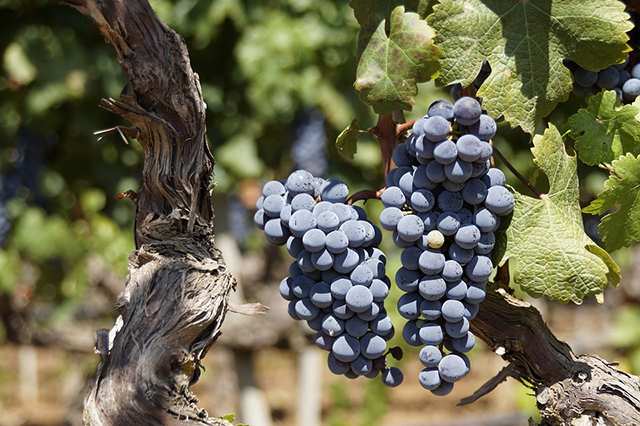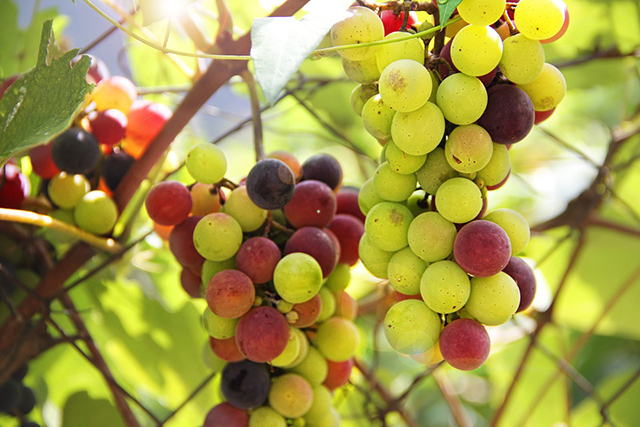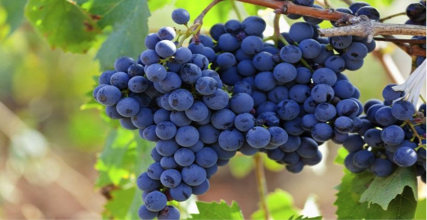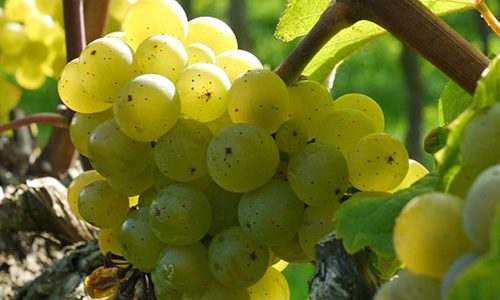葡萄品種特徵入門(一)Major Wine Grapes – Part 1
為了欣賞葡萄酒,了解不同葡萄的特性以及如何在葡萄酒中表達這些特徵是至關重要的。Cabernet Sauvignon(卡本內蘇維濃或稱赤霞珠)、Merlot (梅洛)、Zinfandel(仙粉黛)都是紅葡萄,但在葡萄酒中,他們的個性非常不同。然而,即使以不同的稱謂生長並使用不同的技術進行釀造,特定的葡萄酒總是會顯示葡萄個性中固有的某些特質。 例如,Muscat(馬斯喀特)應該永遠是辛辣的; Sauvignon Blanc觸摸草藥;而Zinfandel(仙粉黛)是非常好吃,有胡椒和野生漿果味道,Cabernet Sauvignon(卡本內蘇維濃或稱赤霞珠)以梅花,黑醋栗和黑櫻桃風味和堅固的單寧為標誌。 了解葡萄的口味特徵是理解葡萄酒的基礎,此外,知道什麼葡萄可以在其中實現.

頂尖美酒鑑賞的精髓
在歐洲最好的葡萄酒主要以地理名稱命名(儘管這種情況正在改變,偶爾會標示法國和意大利葡葡萄品種),然而在其他地方,如美國、澳大利亞、南非、紐西蘭,大多數葡萄酒都以品種名稱標註,甚至有時通過葡萄組合(例如Cabernet-Shiraz)命名,在很大程度上,這是因為在美國會揀選ㄧ些在產區生長過程中最好的葡萄進行組合,美國人是首先以品種名稱引入美酒,歐洲人習慣用地區名稱釀製葡萄酒,歐洲將葡萄類型與土壤和氣候相匹配的歷史較長,研究更具決定性。例如:
Chardonnay(霞多麗)和Pinot Noir(黑皮諾)是勃艮第的主要葡萄.
Cabernet Sauvignon(卡本內蘇維濃或稱赤霞珠),Merlot (梅洛),Cabernet Franc(品麗珠),Malbec(馬爾貝克)和Petite Verdo(小維鐸)是波爾多的紅葡萄.
Syrah(西拉)主導了羅納河北部的紅軍.
Barolo和Barbaresco都是由Nebbiolo製成,但不同的稱謂產生不同風格的葡萄酒。
在義大利托斯卡尼,Sangiovese(桑嬌維塞)提供Chianti(基安蒂)的骨幹。然而,桑尼韋斯的不同clone(克隆)用於Brunello di Montalcino.
最終新世界的命名體系可能會演變成更像歐洲的體系,已經有加利福尼亞州的名稱如Carneros和Santa Maria Valley成為Chardonnay(霞多麗)和Pinot Noir(黑皮諾)的代名詞,俄勒岡州的威拉米特谷以黑比諾和澳大利亞獵人谷以西拉(shiraz、Syrah)而聞名,在加州、盧瑟福、奧克維爾、雄鹿躍區都與Chardonnay(霞多麗)紅葡萄酒相關,在這些稱謂中擁有既得經濟利益的葡萄酒廠和營銷影響力,強調這些地區葡萄酒的獨特特徵,將決定產區系統如何演化及特定的葡萄酒風格是否會出現,這些產區本身也將決定哪些葡萄出類拔萃,值得特別認可,以下是最常用葡萄的描述。美國葡萄酒也是由葡萄原生地命名,特別是(Concord)康科德葡萄釀製而成。葡萄酒按字母順序排列.
BARBERA(紅色)
在意大利的皮埃蒙特地區最為成功,在那裡生產Barbera d’Asti(巴貝拉達斯蒂)、Barbera di Monferato (巴貝拉迪蒙弗拉托)、Barbera di Alba(巴貝拉迪阿爾巴)等葡萄酒,它的葡萄酒具有高度的酸度(意味著亮度和脆度),深紅寶石般的顏色和酒體、單寧含量低,口味是漿果狀的,但是這種葡萄的種植在美國急劇下降,一些葡萄酒廠仍然生產它作為一種葡萄酒,但這些數字也在減少,作為混合酒,即使在炎熱的氣候下,它也具有保持自然高酸度的能力,這種葡萄酒比現在認識到的葡萄酒更具潛力,隨著意大利風格葡萄酒的普及,葡萄酒可能會出現小幅回升.
BRUNELLO(紅色)
這種Sangiovese(桑嬌維賽)葡萄品種是Brunello di Montalcino唯一的葡萄品種,這種稀有而昂貴的托斯卡尼紅葡萄酒,最好的是帶有甜美的黑色和紅色水果以及“耐嚼”的單寧.

CABERNET FRANC(紅色)
作為獨立的品種和混合葡萄,越來越受歡迎,Cabernet Franc(品麗珠)主要用於混合波爾多葡萄酒,儘管其品質可以上升到極高的高度,如大量出現在Cheval-Blanc白葡萄酒中,在法國的盧瓦爾河谷,它也被製成一種名為Chinon(希農)的淡酒,在意大利,特別是東北部,它有時被稱為Cabernet Frank(赤霞珠)或Bordo(博爾多),加州已經發展了30多年,其在華盛頓州,長島,新西蘭和阿根廷的知名度不斷提高, 作為品種的葡萄酒,它通常受益??於少量的Cabernet Sauvignon(赤霞珠)和Merlot(梅洛),然而它可以與任何一種葡萄酒一樣濃郁,但它往往偏離醋栗和漿果的味道,隨著年齡變得更加明顯的草本風味。鑑於其在美國的新穎性,Cabernet Franc(品麗珠)可能只是需要時間來獲得更多的關注和質量的提高,通常與赤霞珠混合blended with Cabernet Sauvignon,它可能是Cabernet Sauvignon赤霞珠突變適應較涼爽的主要因素,通常情況下,中等酒體的葡萄酒比Cabernet Sauvignon赤霞珠葡萄酒更加直接,並且在未熟的赤霞珠葡萄酒中可以看到一些草本的氣味.
CABERNET SAUVIGNON(紅色)
在世界的其他地方,赤霞珠可能會自己裝瓶,也可能是混合裝瓶,它與托斯卡尼的Sangiovese、澳大利亞和普羅旺斯的Syrah、南非的Merlot和Cabernet Franc混合在一起,但在意大利的一些超級托斯卡尼人中獨奏,在美國,任何地區都不可能超過納帕谷的高品質赤霞珠和赤霞珠混釀,通過加利福尼亞的大部分葡萄歷史(可追溯到19世紀),最好的赤霞珠都是100%的赤霞珠,自20世紀70年代後期以來,許多葡萄酒商轉向波爾多模式,將梅洛,品麗珠,馬爾貝克和嬌小維爾多的小部分融入他們的赤霞珠。混合案件仍在審查中,但顯然有成功。另一方面,許多美國生產商正在轉向更高比例的赤霞珠,發現混合不會增加複雜性,赤霞珠本身俱有更強的特性.
無議的紅葡萄酒之王Cabernet在法國的大部分地區都是穩定持久的表演者。雖然它在許多稱謂中都有很好的增長,但在特定的稱謂中,它能夠呈現不尋常的深度、豐富度、濃度和持久性的葡萄酒。波爾多地區自18世紀以來一直使用這種葡萄,並一直將其與品麗珠、美樂及小維鐸的汁液調配在一起。波爾多的模式不僅以製作複雜葡萄酒的渴望為基礎,而且還需要確保不同的葡萄品種在不同的時間,間隔成熟或賦予葡萄酒的顏色、單寧、酒體。
在最好的情況下,未經加工的赤霞珠葡萄酒釀造的葡萄酒味道濃烈,口感濃郁,它的經典口味是醋栗、李子、黑櫻桃和香料,也可以用“我的果醬 ”標記:草本、橄欖、薄荷、煙草、雪松、茴香和成熟。在溫暖的地區,它可以柔順而優雅,在較涼爽的地區,它可以用明顯的植物,甜椒、奧勒岡葉、焦油味道來標記(作為一種晚熟葡萄,赤霞珠並不總是依賴於涼爽的地區,這就是為什麼德國從未使用過這個品種),如果這是所需風格的特徵,它也可以很單寧,最好的赤霞珠以深色紫紅色開始,具有堅實的酸度、飽滿酒體、強烈的味道、濃郁的口感和堅挺單寧.
赤霞珠與橡木有親和力,通常在新的或使用過的法國或美國桶中花費15到30個月,如果執行得當,這種做法賦予葡萄酒一種木質香味的香柏木或香草味,同時緩慢氧化葡萄並柔化單寧,微量氣候是赤霞珠重量和強度的主要因素,釀酒師也會影響風格,因為他們可以提取高含量的單寧和重度橡木酒.
CARIGNAN(紅色)
也被稱為Carignane(加利福尼亞)和Cirnano(意大利), Carignan曾經是一種主要的混合葡萄酒,出現在一些混合酒中,舊葡萄園則因葡萄的強度而受到追捧,這是一種比較稀缺的葡萄酒,因為其他葡萄的強度和風味更強,在很多情況下都取代了它.
CARMENERE(紅色)
這種葡萄也被稱為Grande Vidure,曾經在波爾多廣泛種植,但現在主要與智利有關, Carmenere,Merlot和Cabernet Sauvignon於1850年左右進口到智利,據智利葡萄酒商稱,Carmenere長期以來被貼錯標籤,許多種植者甚至智利政府現在都認為它是美樂.
CHARBONO(紅色)
這種葡萄主要存在於加利福尼亞州(實際上可能與源於意大利皮埃蒙特的多爾切托葡萄有關),這種葡萄的種植面積已經減少,它作為一種葡萄酒的地位主要由Inglenook-Napa Valley支持,該谷地定期裝瓶Charbono,偶爾它會為了有趣的飲用而做出來,並且它很老,但更多的時候它是單寧和單寧 – 故事比實際的葡萄酒更好,一些酒莊仍然生產,但沒有任何成功。
A Primer on Grape Characteristics
In order to appreciate wine, it’s essential to understand the characteristics of different grapes, and how these characteristics are expressed in wines. Cabernet Sauvignon, Merlot and Zinfandel are all red grapes, but in wines their personalities are quite different. However, even when grown in different appellations and vinified using different techniques, a particular varietal wine always displays certain qualities, which are inherent in the grape’s personality.
For example, Muscat should always be spicy; Sauvignon Blanc a touch herbal; while Zinfandel is zesty, with pepper and wild berry flavors. Cabernet Sauvignon is marked by plum, currant and black cherry flavors and firm tannins.
Understanding the taste characteristics of a grape is fundamental to the understanding of wine. Furthermore, knowing what a grape can achieve at its
apex is the essence of fine wine appreciation
In Europe, the finest wines are known primarily by geographic appellation (although this is changing; witness the occasional French and Italian varietals). Elsewhere, however—as in America, Australia, South Africa and New Zealand—most wines are labeled by their varietal names; even, sometimes, by grape combinations (Cabernet-Shiraz, for example). To a large extent, this is because in the United States, the process of sorting-out which grapes grow best in which appellations is ongoing; Americans were first introduced to fine wine by varietal name. Europeans are used to wines with regional names. Europe has a longer history of matching grape types to soil and climate, and the research is more conclusive, e.g.:

Chardonnay and Pinot Noir, for instance, are the major grapes of Burgundy.
Cabernet Sauvignon, Merlot, Cabernet Franc, Malbec and Petite Verdot are the red grapes of Bordeaux.
Syrah dominates northern Rhône reds.
Barolo and Barbaresco are both made of Nebbiolo, but the different appellations produce different styles of wine. In Tuscany,
Sangiovese provides the backbone of Chianti. However, a different clone of Sangiovese is used for Brunello di Montalcino.
In time, the New World’s appellation system may well evolve into one more like Europe’s. Already California appellations such as Carneros and Santa Maria Valley are becoming synonymous with Chardonnay and Pinot Noir, Oregon’s Willamette Valley is known for Pinot Noir and Australia’s Hunter Valley for Shiraz. In California, Rutherford, Oakville and the Stags Leap District are all associated with Cabernet-based red table wines. Wineries, with vested financial interests in these appellations and the marketing clout to emphasize the distinctive features of the wines grown in these areas, will determine how the appellation system evolves and whether specific wine styles emerge. The appellations themselves will also determine which grapes excel and deserve special recognition.
The following are descriptions of the most commonly used Vitis vinifera grapes. American wine is also made from native Vitis labrusca, especially the Concord grape. The wine grapes are presented in alphabetical order.
| BARBERA (Red) [bar-BEHR-uh] |
Most successful in Italy’s Piedmont region, where it makes such wines as Barbera d’Asti, Barbera di Monferato and Barbera di Alba. Its wines are characterized by a high level of acidity (meaning brightness and crispness), deep ruby color and full body, with low tannin levels; flavors are berrylike. However, plantings of this grape have declined sharply in the United States. A few wineries still produce it as a varietal wine, but those numbers too are dwindling. As a blending wine, it has the ability to maintain a naturally high acidity, even in hot climates. The wine has more potential than is currently realized and may stage a modest comeback as Italian-style wines gain popularity.
| BRUNELLO (Red) [broo-NEHL-oh] |
This strain of Sangiovese is the only grape permitted for Brunello di Montalcino, the rare and costly Tuscan red that at its best is loaded with luscious black and red fruits and “chewy” tannins.
| CABERNET FRANC (Red) [cab-er-NAY FRANK] |
Increasingly popular as both a stand-alone varietal and a blending grape, Cabernet Franc is used primarily for blending in Bordeaux, although it can rise to great heights, singularly, in quality, as seen in the grand wine Cheval-Blanc. In France’s Loire Valley, it is also made into a lighter wine called Chinon. It is well established in Italy, particularly the northeast, where it is sometimes called Cabernet Frank or Bordo. California has grown it for more than 30 years, and its popularity is increasing in Washington State, Long Island, New Zealand and Argentina.
As a varietal wine, it usually benefits from small amounts of Cabernet Sauvignon and Merlot. However, it can be as intense and full-bodied as either of those wines. But it often strays away from currant and berry notes into stalky green flavors that become more pronounced with age. Given its newness in the United States, Cabernet Franc may just need time to get more attention and rise in quality. Often blended with Cabernet Sauvignon, it may be a Cabernet Sauvignon mutation adapted to cooler, damper conditions. Typically, light- to medium-bodied wine with more immediate fruit than Cabernet Sauvignon and some of the herbaceous odors evident in unripe Cabernet Sauvignon.
| CABERNET SAUVIGNON (Red) [cab-er-NAY SO-vin-yon] |
The undisputed king of red wines, Cabernet is a remarkably steady and consistent performer throughout much of France. While it grows well in many appellations, in specific appellations it is capable of rendering wines of uncommon depth, richness, concentration and longevity. Bordeaux has used the grape since the 18th century, always blending it with Cabernet Franc, Merlot and sometimes a soup?on of Petite Verdot. The Bordeaux model is built around not only the desire to craft complex wines, but also the need to ensure that different grape varieties ripen at different intervals or to give a wine color, tannin or backbone.
Elsewhere in the world, Cabernet Sauvignon is as likely to be bottled on its own, as well as in a blend. It mixes with Sangiovese in Tuscany, Syrah in Australia and Provence, and Merlot and Cabernet Franc in South Africa, but flies solo in some of Italy’s super-Tuscans. In the United States, it’s unlikely any region will surpass Napa Valley’s high-quality Cabernets and Cabernet blends. Through most of the grape’s history in California (which dates to the 1800s), the best Cabernets have been 100 percent Cabernet. Since the late 1970s, many vintners have turned to the Bordeaux model and blended smaller portions of Merlot, Cabernet Franc, Malbec and Petite Verdot into their Cabernets. The case for blending is still under review, but clearly there are successes. On the other hand, many U.S. producers are shifting back to higher percentages of Cabernet, having found that blending doesn’t add complexity and that Cabernet on its own has stronger character.
At its best, unblended Cabernet produces wines of great intensity and depth of flavor. Its classic flavors are currant, plum, black cherry and spice. It can also be marked by herb, olive, mint, tobacco, cedar, anise, and ripe, “jam-my” notes. In warmer areas, it can be supple and elegant; in cooler areas, it can be marked by pronounced vegetal, bell pepper, oregano and tar flavors (as a late ripening grape, cabernet sauvignon can’t always be relied on in cool areas, which is why Germany, for example, has never used this variety). It can also be very tannic if that is a feature of the desired style. The best Cabernets start out dark purple-ruby in color, with firm acidity, a full body, great intensity, concentrated flavors and firm tannins.
Cabernet has an affinity for oak and usually spends 15 to 30 months in new or used French or American barrels. When properly executed, this practice imparts a woody, toasty cedar or vanilla flavor to the wine, while slowly oxidizing it and softening the tannins. Microclimates are a major factor in the weight and intensity of the Cabernets. Winemakers also influence the style, as they can extract high levels of tannin and heavily oak their wines.
| CARIGNAN (Red) [karin-YAN] |
Also known as Carignane (California), & Cirnano (Italy). Once a major blending grape for jug wines, Carignan appears in some blends, and old vineyards are sought after for the intensity of their grapes. It is a comparatively scarce wine as other grapes with even more intensity and flavor have replaced it, in many cases.
| CARMENERE (Red) [car-men-YEHR] |
Also known as Grande Vidure, this grape was once widely planted in Bordeaux, but is now associated primarily with Chile. Carmenere, Merlot, and Cabernet Sauvignon were imported to Chile around 1850. According to Chilean vintners, Carmenere has been mislabeled for so long that many growers and even the Chilean government now consider it as a Merlot.
| CHARBONO (Red) [SHAR-bono] |
Found mainly in California (and may actually be related to the Dolcetto grape originating from Piedmont, Italy), this grape has dwindled in acreage. Its stature as a wine was supported mainly by Inglenook-Napa Valley, which bottled a Charbono on a regular basis. Occasionally it made for interesting drinking and it aged well. But more often it was lean and tannic – the story was better than the actual wine. A few wineries still produce it, but none with any great success.



